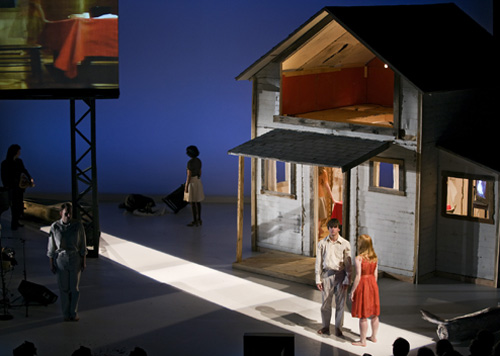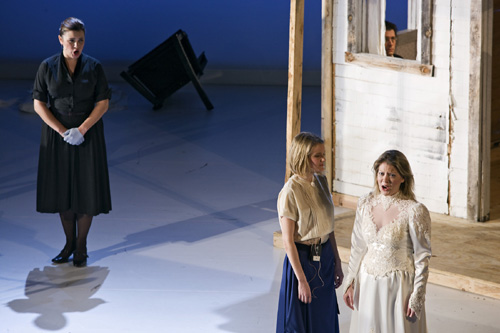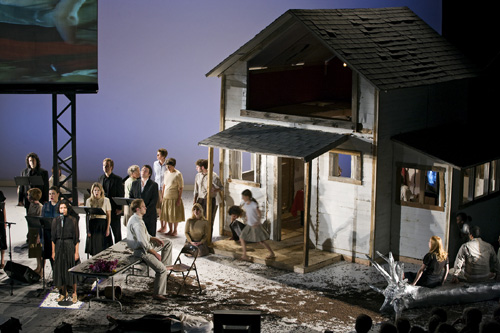|
What does new American opera look and sound like? This critic suggests new American opera both embraces what is innovative with subtle incorporation of what is old and in achieving a finely tuned balance awakens its audience in that fleeting window of the present moment. Such operas happen with rare frequency because any opera premiere is expensive and requires the support and cooperation of exponentially more people then are seen on stage during such a production. This critic had the rare pleasure to experience such an opera off the beaten path at the Walker Art Center's McGuire Theater in Minneapolis, Minnesota, when she attended on December 12, 2008, the opening night performance of The Making of Americans by composer Anthony Gatto and director Jay Scheib based on text Scheib took from Gertrude Stein's ground-breaking novel The Making of Americans: Being a History of a Family's Progress.

NARROWING 900 PAGES TO 100 MINUTES
For anyone who has had the curiosity and courage to dip into Stein's 900-page-plus novel, which is filled with the painstaking details of a middle class family across many generations, one would now be wondering what aspect of this non-narrative novel Scheib featured in this 100-minute opera. The best way to answer this is to provide the synopsis listed in the Walker Art Center program brochure:
Prelude
Act 1
Scene 1: Mr. Hersland, Sr. [David] reflects on the loss of his wife, Mrs. Hersland [Fanny].
Scene 2: History is repeating, changing. Martha Hersland [daughter of David and Fanny Hersland] considers going on for a whole life repeating oneself.
Scene 3: The marriage of Julia Dehning and Alfred Hersland [son of David and Fanny Hersland].
Act 2
Scene 1: Martha Redfern-Hersland reflects on her recent divorce.
Scene 2: Alfred Hersland and Julia Dehning break up and reflect on breaking up.
Scene 3: The funeral oratorio of David Hersland [Jr. and is the son of David and Fanny Hersland] having eaten himself to death, he reflects on his life, his lover, Mary Maxworthing, and his family.
Epilogue
Mary Maxworthing reflects on living and dying and the permanent becoming of being in family living.
To Scheib's credit, his interpretation of Stein's generational saga based on the psychological portraits of her parents—represented in the novel by David and Fanny Hersland—and other family members—is not literal or chronological. For example, Stein opens her novel with the apocryphal vignette of the angry man who drags his father through the old man's orchard while the father shouts, "Stop, I did not drag my father beyond this tree." While Scheib does enact this powerful moment, he does not open the opera in this way. In the applied method of Stein, Scheib goes for a cross-pollination of artistic forms. In his program notes, he writes, "This opera is neither a painted canvas, nor sculpture, nor literature but some unusual combination of all of these. What we are seeing will be informed by what we are hearing."

THE CONVERSATION OF OPPOSITES
As the audience entered the three hundred and fifty seat auditorium which was mostly filled, two women periodically rolled through the stage as if swept along by a hurricane force, except they looked like figures being viewed in slow motion film footage. In Chris Larson's design, the stage featured a two-storey house outfitted with a video camera as well as a small orchestra and a projection screen where video footage shot from within the house could be seen by the audience. In addition to the musical performance by singers and orchestra, spoken voice performance, and streaming and freeze-frame video projections, the production integrated fluid choreography that often had elements of yoga postures. These antithetical combinations: sung versus spoken words, live versus still video projection, and active dance versus yoga postures produced a surprising dialectic in this reviewer. Did I see what I thought I saw? Did I hear correctly what was delivered? Yes, these elements were repeated so there was time to digest what was being shaped and delivered from the stage. In Gertrude Stein's vocabulary, the "syncopation"—the gap in time between what was delivered on stage and what was received by the audience member—narrowed to a comfortable interval of real time, achieving engagement in the present moment.

Anthony Gatto's music also achieved a conversation of opposites. For example, in scene 1, Mrs. Hersland sang in a musical style reminiscent of plainchant, a type of monophonic music going back to the sixth century, A.D. and associated with religious liturgy, while Mr. Hersland, in answer to his wife, sang in a style reminiscent of the twentieth century cutting-edge music theater work of Kurt Weill, such as The Three Penny Opera. Other musical styles that entered Gatto's palette included compositions that sounded like Jewish folk songs, a nod to Aaron Copland's opera The Tender Land, and stately Renaissance airs.
If one listens to the prelude to The Making of Americans, one hears a Minimalist repetition of church bells that seems to tick out an urgency about life in general. Greatly enhancing the delivery of the music for this production was a collaboration between Zeitgeist, a chamber music group of two percussionists, a woodwind player and a keyboardist, and the JACK Quartet, a New York City-based string group of violins, viola, and cello.
By no means does this reviewer intend to intimate that Gatto's music is either derivative or unfocused. Gatto has achieved with this original, lyrical, and mostly tonal work a fine balance between subtle references to the history of musical styles and his own musical voice. With this anchor into the distant and near past, he achieves an integrity that wakes up the senses and is highly compatible with what Jay Scheib accomplishes in his mise-en-scène or, as Scheib prefers, gesamtkunstwerk, a term coined by Richard Wagner referring to operatic work that integrates music, theater, and visual arts.
Another aspect of Gatto's yin-yang sensibility was his edgy introduction of a countertenor, which this critic thought came to represent the voice of Gertrude Stein. Gatto wrote the part of David Hersland, Jr. for the accomplished performer David Lee Echelard who brought his Volksgurdy, a contemporarily made Hurdy-gurdy based on Renaissance design, to the stage as melodic (and not the typical drone) accompaniment for his plaintive but sensual aria about how Julia was the only one who found him worthy and important. Occasionally, contemporary opera draws on the resources of rare countertenor voices that typically find opportunities in the Early Music arena. Echelard's challenging and moving performance in Act 2 requires him to sing about sadness (the sadness that comes when no one listens) while lying belly down on a table. In this aria, the countertenor channels the voice of Gertrude Stein, but it could also be the voice of a new music and opera composer.
SPOKEN WORD ACTOR'S TOUR DE FORCE PERFORMANCE
Periodically through the scenes, a mysterious woman walked around the stage with a bouquet of flowers. Eventually, one came to the understanding that she was David Hersland, Jr.'s lover, Mary Maxworthing. According to an email exchange with Jay Scheib on January 8, 2008, Mary Maxworthing is a character in Stein's novel that Scheib has "loosely associated with David, Jr." In the epilogue, Tanya Selvaratnam as Mary Maxworthing executes an extended spoken word performance with tears streaming down her face that heightens the emotional wallop of the opera and especially harkens back to Echelard's sadness aria even if one is uncertain who this woman was. The combined effect of the tail end of the opera presents like the cemetery scene in Thornton Wilder's Our Town, which seems entirely appropriate since Stein greatly influenced Wilder before he wrote this classic for American theater. If anything would convince a lover of fine literature to pick up The Making of Americans, Stein's hefty tome, it would be Selvaratnam's performance at the close of this extraordinary chamber opera.
THE MELDING OF IMAGE AND MOVEMENT
While the use of video and film footage is happening more often in theatrical stagings, Scheib's use of video meshed well with the structure of Stein's psychological novel, which does not follow a linear path. It also had the effect that reality TV creates with its "spying" on the lives of ordinary people. Much to Scheib's good judgment, the video aspect did not overwhelm the live performance, which was also accented in compelling ways by the choreography. The odd thing about the dancers that Scheib chose for this production is that they were not per say professional dancers, but students or graduates of Massachusetts Institute of Technology (MIT) in such subjects as neuroscience. Nevertheless, the dancing was every bit as moving as anything on stage by known modern dance companies founded by such greats as Alvin Ailey, Paul Taylor, or Merce Cunningham. Costuming for the dancers created by Oana Botez-Ban especially caught this critic's eye. The understated costumes seemed appropriately attractive to movement but also entirely comfortable for the dancers.
Most of the innovative American opera is taking place in tiny windows of time and often in places off the beaten path if one considers major cities, starting with New York, the cultural hubs for such events. Universities and colleges, as opposed to well-known opera companies, often are major players in producing new operatic works. In the case of Gatto's and Scheib's The Making of Americans, the producing organization was an art museum but hardly a warehouse for relics.
Photos - Cameron Wittig
|


